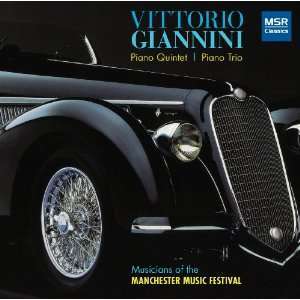|
Back
11/23/2012
Vittorio Giannini: Quintet for Piano and Strings – Trio for Piano and Strings
Joana Genova (Violin I), Stefan Milenkovich (Violin II), Ariel Rudiakov (Viola), Ani Aznavoorian (Violincello), Adam Neiman (Piano)
Recording: Troy Savings Bank Music Hall, New York (January 10-13, 2011) – 61’
MSR Classics #MS 1394 – Booklet in English

   
Vittorio Giannini is not a name that readily comes to mind in the sphere of mainstream classical music, but now is a time to become better acquainted with this independent and adventuresome composer of the Neoromantic age. Giannini parted ways with the Neoclassical lineage by holding onto vestiges of the Romantic movement, putting his own stamp of individualism onto all of his compositions.
“Allegro con spirito” from the Quintet utilizes a soulfully gray 5/4 time which Ariel Rudiakov describes on viola with indelible moodiness. Akin to the “Andantino” from Debussy’s String Quartet in G Minor, Ani Aznavoorian ushers in attenuated impressions during the “Adagio” soon to be followed by Genova and Milenkovich on violin. The music intensifies with Far Eastern spiciness by Adam Neiman on piano complete with lush and contemplative scales and tinkling melody lines, at times giving glimpses of Erich Korngold’s cinematic perspective. Piano and strings prey upon each other in immediate spots of the “Allegro” that take turns with an intervening, restless march-like stampede grounded in throbbing tension. The music is dense and labored.
The Trio for Piano and Strings presents lighter fare compared to its predecessor, one that embraces lyrical niceties, sweeping lines and restraints, giving the “non troppo” nomenclature bonafide meaning. The movement takes in a deep breath of juxtaposition with optimistic finishes. Stefan Milenkovich’s violin picks up the emotive fervor and dramatic sadness in “Andante triste”, and this teems with hopeful magnificence. The thematic dialogue never gets away from us in the “Allegro non troppo, con eleganza.” The final three chords strike like an impish “ha-ha.” It makes us reminisce about what we just heard and about Vittorio Giannini’s contributions to classical music.
This world-premiere recording deserves special recognition not only for the momentous occasion but also for the impressive interpretation of this intriguing music.
Christie Grimstad
|